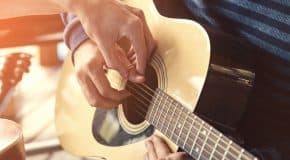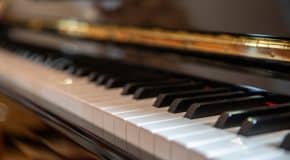
By the time a student reaches the level of intermediate guitar lessons, they are probably interested in exploring all of the different sounds they can possibly get out of the instrument. The guitar is an instrument that changes drastically based on the gear you have for it, especially in regards to electric guitars. A guitarist may spend years cultivating the perfect sound for every occasion on his or her instrument. Here is a basic guide to all you can explore with different equipment.
Acoustic Guitars
It is probably more common to start guitar lessons on an acoustic guitar. Acoustic guitars are the standard guitars you may be used to seeing that do not require an electric components to make a sound. Even though there are no electric components in the acoustic guitar, the sound can still vary drastically depending on what kind of acoustic you get. Perhaps you are no longer a beginner and are taking intermediate guitar lessons. At this point, you probably want to invest in a nicer sounding acoustic guitar. Purchasing a higher level guitar guitar will increase the range of sound and make your already great playing sound even better.
Electric Guitars
Perhaps you’ve been playing on an acoustic guitar for a few years, but want to start experimenting with an electric sound. Electric guitars are the guitars we are used to seeing in rock and pop music. These guitars use pickups to convert the vibration of the strings into an electric signal that needs to be amplified in order to hear the full range of sound. This electrical signal can be manipulated in many ways to create a multitude of sounds.
Amplifiers

Electric guitars require the use of an amplifier to be heard through a loudspeaker. These amplifiers (often plainly called guitar amps) come in many shapes and sizes. Different amps create different overall sounds. A smaller amp may have a more limited frequency response than a larger amp. There are often controls on these amps that adjust the sound coming through them as well. These controls often include treble, bass, reverb, and other parameters that can affect the overall tone of the guitar. Ask your intermediate guitar lessons teacher which amp is right for you.
Pedals
As if we didn’t have enough control over tone already, we can also purchase stand-alone effects boxes to further manipulate the sounds that get fed from the guitar to the amplifier. These effects boxes that you control with your feet are called pedals. Basically, there are pedals for every effect you can think of: delay, chorus, distortion, reverb, compression, etc. Guitarists often collect these pedals over the years to shape their personal tone to match their taste. Of course, all of these pedals have parameters that you can change, so even though you have all of these different effects pedals, you can constantly change the sounds by changing the parameters. Therefore, the more pedals you have, the more sound options you have.
Pedal-boards
Seasoned guitarists may develop a small collection of effects pedals over time and chain them together to match their needs. At this point, many guitarists choose to purchase a pedal-board. A pedal-board can serve many purposes. In its most basic purpose, a pedal-board provides a container for all of your pedals, making it simple to pack up and transport all pedals in a convenient way. A pedal-board may also be able to provide necessary power to all of your pedals without having to plug each pedal separately into a power source. If you have acquired many pedals over the years, a pedal-board is a very useful item.
Conclusions About Intermediate Guitar Lessons and Gear
Basically, there are infinite possibilities for creating different sounds out of a guitar. It takes a lot of time and practice to figure out the gear and the sounds that work best for you. If you need help or recommendations, always ask your intermediate guitar lessons teacher for advice and have fun with all of the new sounds you can create!


